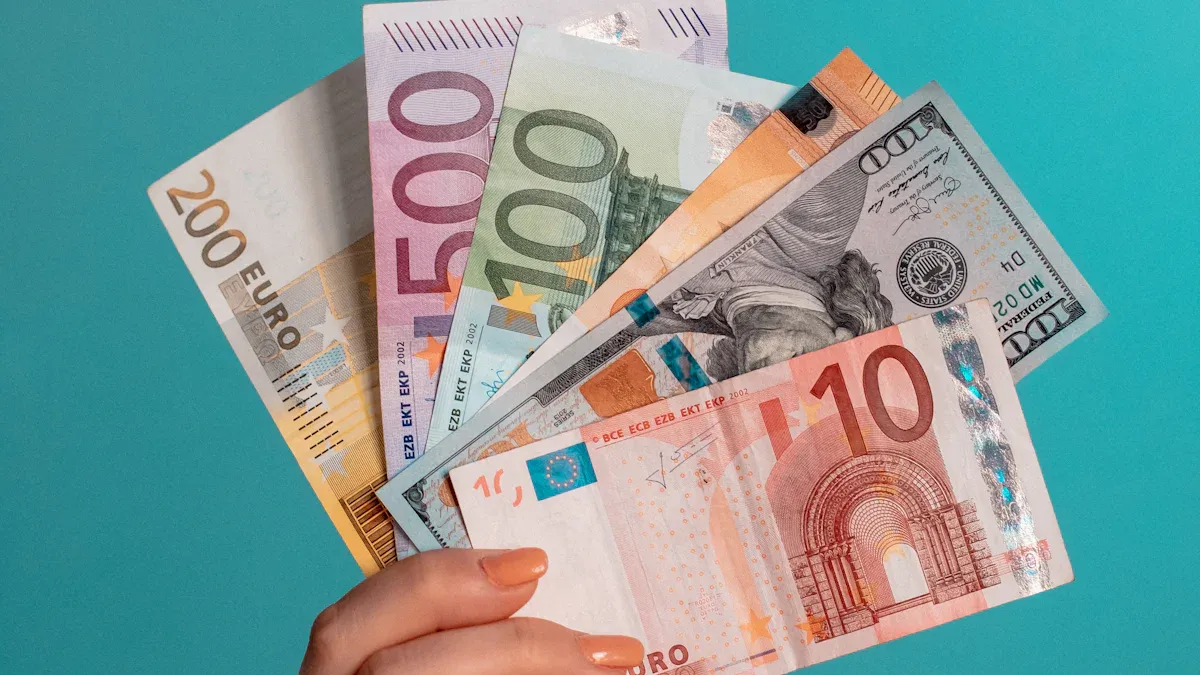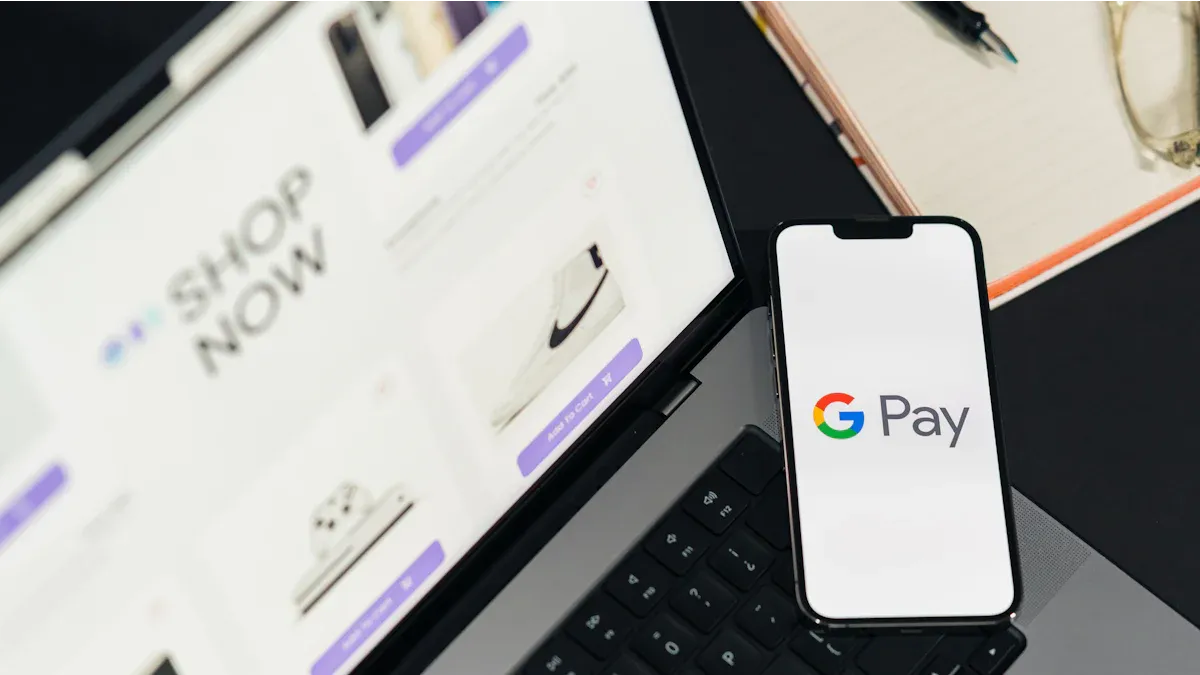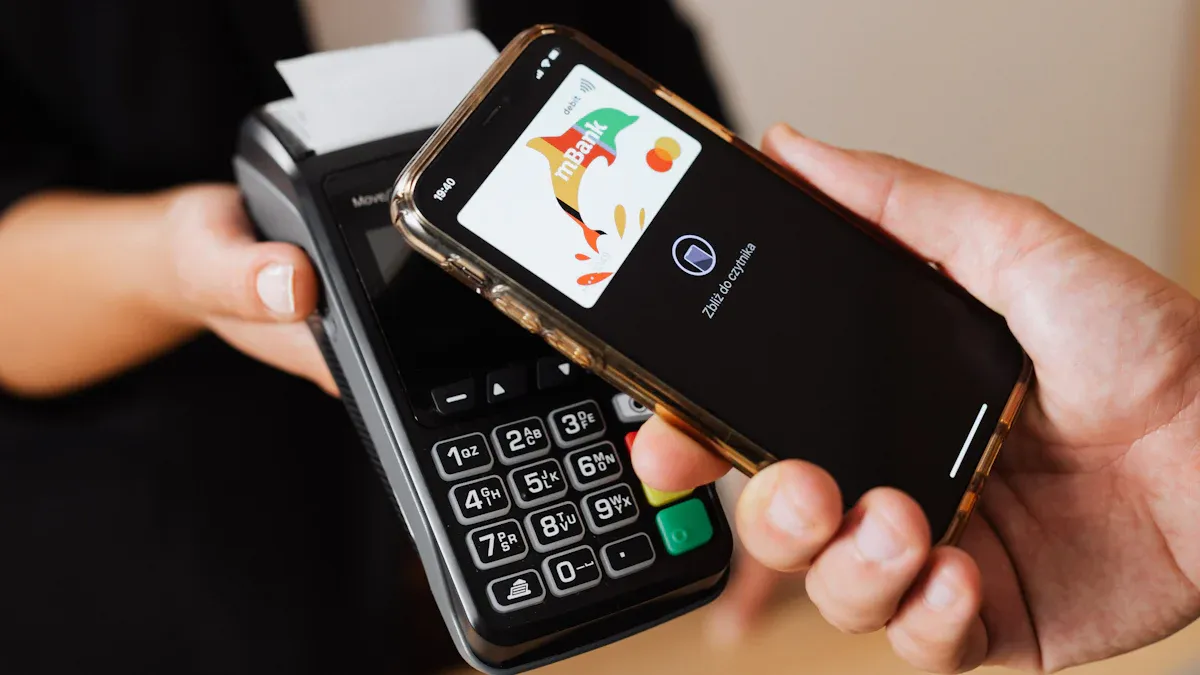- EasyCard
- Trade
- Help
- Announcement
- Academy
- SWIFT Code
- Iban Number
- Referral
- Customer Service
- Blog
- Creator
Advantages and Precautions of Google Pay in International Payments, and How to Use Google Wallet for Cross - border Payments

Image Source: unsplash
When making international payments, you may worry about complex operations or information leaks. Google Pay offers a convenient experience, helping you complete various payments effortlessly. You only need to hold your phone near a terminal to complete a payment, without carrying cash or bank cards. Google Wallet supports multiple currencies, allowing you to make cross-border payments. You can stay informed about exchange rate changes, with clear and transparent fees. Google Pay’s advantages enable you to enjoy secure and efficient payment services worldwide.
Key Points
- Google Pay provides a convenient payment experience, requiring only a phone near a terminal to complete payments, without needing cash or bank cards.
- When using Google Pay for international payments, ensure the target country supports the service to avoid payment failures.
- Google Pay employs multiple security measures, including end-to-end encryption and two-factor authentication, to protect user payment information.
- Be aware of potential fees; Google Pay itself does not charge fees, but the linked payment card may incur foreign transaction fees.
- For cross-border payments, ensure the account currency matches the payment currency to avoid transaction errors and additional fees.
Google Pay Advantages

Image Source: pexels
Convenience
When using Google Pay, you’ll find the payment process very simple. You only need to hold your phone near an NFC-enabled terminal to complete a payment, without carrying cash or bank cards. Google Pay supports multiple payment methods, including credit cards, debit cards, and digital wallets. You can easily use it in stores, restaurants, or online platforms in the U.S. market.
Google Pay’s convenience stands out in user satisfaction surveys. The table below shows user satisfaction and features of major international payment platforms:
| Payment Platform | User Satisfaction | Features |
|---|---|---|
| Google Pay | 78% | Reward system, real-time transaction tracking |
| Apple Pay | 68% | Faster in-store payment experience |
| Google Pay | 61% | Personal finance insights, budgeting tools |
Google Pay’s advantages also lie in its seamless cross-border payment experience. You can perform international remittances between supported countries, track each transaction’s status in real-time, and manage payments more efficiently. Google Pay supports multiple currencies, simplifying the cross-border transaction process, so you don’t need to worry about currency conversion when shopping in the U.S. or other countries.
- Google Pay allows you to make international remittances between countries, simplifying cross-border transactions.
- Supports multiple currencies, making cross-border payments simple and seamless.
- Real-time tracking lets you stay updated on payment status.
Security
When making international payments, your primary concern is fund security. One of Google Pay’s advantages is its use of multiple security measures to protect your account and transactions. Google Pay uses end-to-end encryption to ensure your payment information and personal data are not leaked. Each transaction generates a unique token, avoiding the storage of actual credit card numbers. You can enable two-factor authentication to add an extra layer of account protection.
Google Pay also supports biometric authentication, such as fingerprint scanning or facial recognition, ensuring only you can authorize payments. The system actively monitors account activity and sends alerts for unusual transactions. You can confidently use Google Pay for international payments in the U.S. market or other countries.
- Google Pay uses end-to-end encryption to protect sensitive data.
- Each transaction generates a unique token to prevent credit card information leaks.
- Two-factor authentication and biometric authentication enhance account security.
- Activity monitoring and alerts help you detect unusual transactions promptly.
Global Coverage
Google Pay’s advantages extend beyond convenience and security to its extensive global coverage. You can use Google Pay for international payments in 97 countries and regions. Whether you’re in the U.S., Europe, or Asia, as long as the location supports Google Pay, you can enjoy an efficient payment experience.
The table below shows Google Pay’s global coverage:
| Payment Method | Number of Available Countries |
|---|---|
| Google Pay | 97 |
When using Google Pay in mainland China, you need to consider local policies and support. The U.S. market has strong support for Google Pay, offering a smoother cross-border payment experience. Google Pay’s advantages allow you to complete payments effortlessly worldwide, without worrying about regional restrictions.
Fee Transparency
When making international payments, you often worry about hidden fees. Google Pay’s advantages include fee transparency. Google Pay itself does not charge transaction fees. When using Google Pay, you may incur fees from the linked payment card, particularly foreign transaction fees for credit cards. For international payments, Google Pay recommends using professional services like Wise, which offers transparent fees and mid-market exchange rates.
The table below shows the typical fee structure for international payments:
| Fee Source | Fee Type | Description |
|---|---|---|
| Google Pay | No Fees | Google Pay itself does not charge fees. |
| Bank or Card Issuer | Foreign Transaction Fees | When using a credit card, approximately 3% fees may apply. |
| Wise | Low Conversion Fees | When using Wise, conversion fees are 0.41%. |
- Google Pay does not directly charge transaction fees.
- You may incur foreign transaction fees from the linked payment card, so check relevant policies in advance.
- Using professional services like Wise provides more transparent fees and exchange rate information.
Google Pay’s advantages allow you to clearly understand the fees and exchange rates for each transaction during international payments, avoiding unnecessary losses. You can view fee details at any time to make more informed payment decisions.
Considerations
Country/Region Restrictions
Before using Google Pay or Google Wallet for international payments, you must confirm whether the target country or region supports the service. Some countries and regions currently do not support Google Pay’s international payment functions. You can use it smoothly in the U.S. market, but cross-border payments may not be available in the following regions:
- Egypt
- Slovenia
- Mexico
- Turkey
Different countries have varying regulations and laws for remittance services. International transfers involve multiple financial institutions with strict compliance requirements. Google Pay also needs to establish partnerships with local banks and payment processors. When using it in mainland China, you need to consider local policies and support. It’s recommended to check Google’s official support page before making payments to ensure service availability.
Tip: You can set Google Pay as the default payment app in your device settings and ensure your phone supports NFC to complete payments smoothly.
Currency Consistency
When making international payments, the account currency must match the payment currency. If the currencies don’t match, the system may encounter transaction errors. For example, the system may prompt “the payment currency must match the bank account’s currency.” When processing transactions in specific countries, such as Canada’s ACSS system, currency mismatches can complicate payment integration. When using USD for payments in the U.S. market, ensure your account is also USD-based to avoid additional exchange rate conversions and technical issues.
- Currency mismatches may lead to transaction failures.
- The system will display error messages, affecting the payment experience.
- For cross-border payments, ensure the account and payment currencies match in advance.
Transaction Fees
When using Google Pay for international payments, you need to be aware of potential transaction fees. Google Pay itself does not charge service fees, but the linked credit or debit card may incur foreign transaction fees from the bank. The table below compares the fee structures of major international payment services:
| Payment Service | International Transaction Fees |
|---|---|
| Google Pay | No fees, but linked card fees may apply |
| Apple Pay | No fees, but linked card fees may apply |
| PayPal | Complex fee structure, fees apply for international transactions |
Google Pay and Apple Pay generally offer better pricing for consumers. PayPal charges fees for international transactions, especially when currency conversion or credit/debit card payments are involved. When using Google Pay in the U.S. market, choose a low-fee linked card and check bank policies in advance to avoid unnecessary expenses.
Exchange Rate Differences
When making cross-border payments, exchange rate fluctuations directly affect the actual payment amount. Google Pay displays real-time exchange rates, but banks or third-party payment providers may use different rate standards. When paying in USD in the U.S. market, if the recipient’s account is in another currency, the bank will automatically convert the currency. Some banks may charge a rate spread, reducing the actual amount received. You can check exchange rates in advance and choose a service provider with transparent rates to minimize exchange rate losses.
Recommendation: Before making a payment, use Google Pay or the linked bank’s exchange rate calculator to verify the actual amount received and avoid losses due to rate fluctuations.
Account Security
Account security is critical during international payments. Google Wallet uses tokenization to protect your card information, storing a virtual account number instead of the actual card number for transactions. When using Google Wallet, you must provide authentication methods such as a password, PIN, fingerprint, iris scan, or 3D facial scan to ensure only you can authorize payments. If your phone is lost or stolen, you can remotely lock the device, sign out of your Google account, or erase data using Google’s Find My Device to secure your account.
You should also be cautious of the following common cross-border payment scams:
- Fake Refund Scams: Scammers impersonate customer support, tricking you into entering payment information.
- QR Code Scams: Scammers send malicious QR codes that authorize payments or leak sensitive data when scanned.
- Marketplace Payment Requests: Buyers fake payment confirmations, sending fraudulent requests to induce payments.
- Romance Scams: Scammers pose as romantic partners, building trust to request remittances.
- Fake Tech Support Scams: Impersonators posing as Google or tech support trick you into installing remote access tools.
- Advance Payment Scams: Fake job or product ads require upfront payments, then disappear after receiving funds.
When using Google Pay in the U.S. market or other countries, always verify the recipient’s identity, avoid scanning unknown QR codes, and be wary of unsolicited refund or tech support requests. It’s recommended to regularly check account activity, enable multi-factor authentication, and enhance security protection.
Operation Process

Image Source: pexels
Activation and Linking
To use Google Wallet for cross-border payments, you first need to activate the account and link a payment method. Follow these steps:
- Open the Google Wallet app.
- Tap the “Add to Wallet” option in the bottom right corner.
- Select “Payment Card.”
- Click “New Credit or Debit Card.”
- Use the camera to scan the card or manually enter details.
- Follow the on-screen prompts to complete linking.
You need to be at least 16 years old. If under 18, parental permission is required. You also need a Google account. Your phone must support NFC and run Android 5.0 or higher. It’s recommended to use a credit or debit card issued by a licensed Hong Kong bank for linking to increase payment success rates.
Tip: In the U.S. market, Google Wallet supports card linking from multiple banks. Check the supported list in the app to ensure smooth activation.
Adding Recipients
After linking a payment method, you need to add recipient information. In the Google Wallet app, you can select a contact or manually enter the recipient’s name and account details. For the first transfer, the system will prompt you to enter detailed recipient information. You can save frequently used recipients for future convenience.
- Select a contact or enter recipient information.
- Provide the recipient’s bank account or digital wallet details.
- Save recipient information to improve payment efficiency.
Selecting Currency
When making cross-border payments, you need to choose the appropriate currency. Google Wallet supports multi-currency payments. You can select USD or other currencies based on the recipient’s country. The system automatically displays real-time exchange rates to help you calculate the actual amount received.
Recommendation: When paying in the U.S. market, prioritize USD to avoid additional exchange rate conversion fees. The system will show the current rate and estimated amount received.
Entering Amount
You need to enter the payment amount. Google Wallet has amount limits for different user types. The table below shows specific amount requirements:
| User Type | Minimum Amount | Maximum Amount | Per Transaction Limit |
|---|---|---|---|
| Unverified User | $500 | $500 | $2,000 |
| Verified User | N/A | $5,000 | $2,000 |
If you enter a large amount, the system may require identity verification. You can enable identity verification to enhance account security. Verification includes bank card details and personal identity confirmation.
- When entering the amount, the system automatically checks limits.
- Large payments require identity verification to ensure fund security.
Completing Payment
After completing the above steps, you can submit the payment request. Follow this process:
- Open the Google Pay or GPay app.
- Find the contact you want to send money to.
- Click the Pay button.
- Select Wise or Western Union as the transfer provider.
- For first-time payments, add recipient payment information.
- Submit and complete the transaction.
- The system displays a status message, and the transaction is completed.
You can track payment status in real-time within the app. If issues arise, you can get help through Google Wallet’s customer service. Common issues include payment failures, verification issues, or incorrect recipient information. You can find solutions in the help center or contact customer service directly.
Tip: When using Google Wallet in the U.S. market, verify recipient information and exchange rates in advance to ensure smooth payments.
You can leverage Google Pay’s advantages of convenience, security, and global coverage for international payments. When making cross-border payments, pay attention to country/region support, currency consistency, and transaction fees. Use cards issued by licensed Hong Kong banks and prioritize USD amounts. Regularly check account security to avoid scams.
Recommendation: When using Google Wallet in the U.S. market or mainland China, follow the official process to ensure compliance and enhance the international payment experience.
FAQ
Which Countries Support Google Wallet for Cross-Border Payments?
You can use Google Wallet for cross-border payments in the U.S. market and 97 countries worldwide. Some regions in mainland China may not be supported. Check Google’s official support page before paying.
How Can I Avoid High Fees for Google Pay Cross-Border Payments?
You can link a credit or debit card issued by a licensed Hong Kong bank to Google Pay. Check bank policies in advance and choose low-fee payment methods.
Are There Amount Limits for Google Pay Cross-Border Payments?
When using Google Pay, unverified users have a per-transaction limit of USD 2,000, while verified users have a maximum limit of USD 5,000. Large amounts require identity verification.
How Can I Ensure Account Security and Prevent Scams?
You can enable two-factor authentication and biometric features. Regularly check account activity, avoid scanning unknown QR codes, and be cautious of unsolicited refund or tech support requests.
How Are Exchange Rates Calculated? Will the Actual Amount Received Vary?
You can view real-time exchange rates in Google Wallet during payments. Banks or third-party providers may use different rates, which may cause slight variations in the actual amount received.
When leveraging Google Pay or Google Wallet for international payments, you might grapple with regional restrictions (like partial unavailability in mainland China), around 3% foreign transaction fees from linked cards, and cross-border transfers confined to select destinations (e.g., from the US to India or Mexico), often compounded by opaque exchange rates or extra verifications. BiyaPay, a dedicated global finance platform, elegantly overcomes these barriers with broader, more accessible cross-border capabilities. Our remittance fees dip to just 0.5%, beating credit card surcharges, and enable seamless swaps across 30+ fiat currencies and 200+ cryptos using clear real-time rates, so you avoid surprise spreads and maximize delivered value on every payment.
With just a few minutes of quick registration, BiyaPay enables same-day remittance and same-day delivery to over 150 countries and regions, including the US, Europe, and key Asian markets. Fund your account via bank transfer and send money securely to recipients’ bank accounts abroad—simple, efficient, and going far beyond Google Pay’s limitations in cross-border payments.With end-to-end encryption and biometric verification aligned to worldwide regulations, BiyaPay proactively flags irregularities, outpacing tokenization against scams. Best of all, on this all-in-one hub—no extra accounts required—you can trade US and Hong Kong stocks, enjoying zero-fee contract orders to blend payments with portfolio growth.
Dive in with BiyaPay right away! Harness the Real-Time Exchange Rate Query to preview multi-currency costs precisely, refining your global spends. Activate Stocks for integrated financial elevation. Enroll in BiyaPay today, shattering Google Pay’s geographic confines for secure, transparent, and limitless cross-border payments—transform every transaction into a breeze!
*This article is provided for general information purposes and does not constitute legal, tax or other professional advice from BiyaPay or its subsidiaries and its affiliates, and it is not intended as a substitute for obtaining advice from a financial advisor or any other professional.
We make no representations, warranties or warranties, express or implied, as to the accuracy, completeness or timeliness of the contents of this publication.




Contact Us
Company and Team
BiyaPay Products
Customer Services
is a broker-dealer registered with the U.S. Securities and Exchange Commission (SEC) (No.: 802-127417), member of the Financial Industry Regulatory Authority (FINRA) (CRD: 325027), member of the Securities Investor Protection Corporation (SIPC), and regulated by FINRA and SEC.
registered with the US Financial Crimes Enforcement Network (FinCEN), as a Money Services Business (MSB), registration number: 31000218637349, and regulated by FinCEN.
registered as Financial Service Provider (FSP number: FSP1007221) in New Zealand, and is a member of the Financial Dispute Resolution Scheme, a New Zealand independent dispute resolution service provider.



















